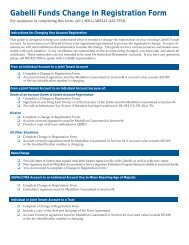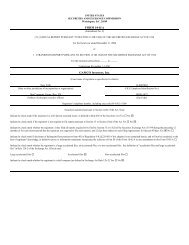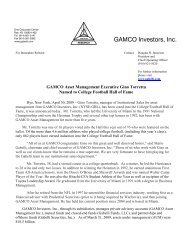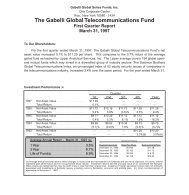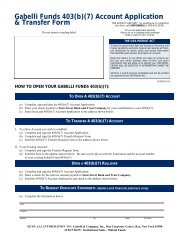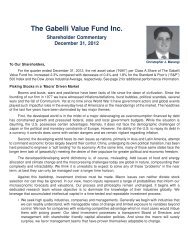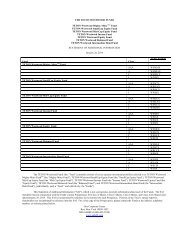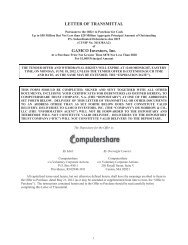Original GBL Prospectus - Gabelli
Original GBL Prospectus - Gabelli
Original GBL Prospectus - Gabelli
You also want an ePaper? Increase the reach of your titles
YUMPU automatically turns print PDFs into web optimized ePapers that Google loves.
investment product oÅerings, enhanced distribution and marketing of existing investment products, upgraded<br />
management information systems and strategic acquisitions as opportunities arise. At present, the Company<br />
has no plans, arrangements or understandings relating to any speciÑc acquisitions or alliances. The Company<br />
currently does not intend to use any of the net proceeds from the OÅering to pay debt service on the $50<br />
million payable to Mr. <strong>Gabelli</strong> under the terms of his Employment Agreement.<br />
Recent Accounting Developments<br />
In 1997, the Financial Accounting Standards Board (""FASB'') issued Statement of Financial Accounting<br />
Standards (""SFAS'') No. 130 (""Reporting Comprehensive Income'') and SFAS No. 131 (""Disclosure<br />
about Segments of an Enterprise and Related Information''). These statements, which are eÅective for periods<br />
beginning after December 15, 1997, expand or modify disclosures. In addition, in 1998, the FASB issued<br />
SFAS No. 133 (""Accounting for Derivative Instruments and Hedging Activities''). SFAS No. 133 establishes<br />
standards for recognizing and fair valuing derivative Ñnancial instruments. SFAS No. 133 is required to be<br />
adopted for Ñscal years beginning after June 15, 1999. The Company does not expect implementation to have<br />
any signiÑcant eÅect on the Company's reported Ñnancial position or results of operations.<br />
Seasonality and InÖation<br />
The Company does not believe its operations are subject to signiÑcant seasonal Öuctuations. The<br />
Company does not believe inÖation will signiÑcantly aÅect its compensation costs as they are substantially<br />
variable in nature. However, the rate of inÖation may aÅect Company expenses such as information<br />
technology and occupancy costs. To the extent inÖation results in rising interest rates and has other eÅects<br />
upon the securities markets, it may adversely aÅect the Company's Ñnancial position and results of operations<br />
by reducing the Company's assets under management, revenues or otherwise. See ""Risk Factors Ì Potential<br />
Adverse EÅects on the Company's Performance Prospects from a Decline in the Performance of the<br />
Securities Markets.''<br />
Year 2000 Program<br />
With the new millennium approaching, many institutions around the world are reviewing and modifying<br />
their computer systems to ensure that they are Year 2000 compliant. The issue, in general terms, is that many<br />
existing computer systems and microprocessors with date functions (including those in non-information<br />
technology equipment and systems) use only two digits to identify a year in the date Ñeld with the assumption<br />
that the Ñrst two digits of the year are always ""19''. Consequently, on January 1, 2000, computers that are not<br />
Year 2000 compliant may read the year as 1900. Systems that calculate, compare or sort using the incorrect<br />
date may malfunction.<br />
Because the Company is dependent, to a very substantial degree, upon the proper functioning of its<br />
computer systems, a failure of its systems to be Year 2000 compliant could have a material adverse eÅect on<br />
the Company. For example, a failure of this kind could lead to incomplete or inaccurate accounting or<br />
recording of trades in securities or result in the generation of erroneous results or give rise to uncertainty about<br />
the Company's exposure to trading risks and its need for liquidity. If not remedied, potential risks include<br />
business interruption or shutdown, Ñnancial loss, regulatory actions, reputational harm and legal liability.<br />
In addition, the Company depends primarily upon the proper functioning of third-party computer and<br />
non-information technology systems. These parties include trading counterparties; Ñnancial intermediaries<br />
such as stock exchanges, depositories, clearing agencies, clearing houses and commercial banks; subcontractors<br />
such as third-party administrators; and vendors such as providers of telecommunication services,<br />
quotation equipment and other utilities. If the third parties with whom the Company interacts have Year 2000<br />
problems that are not remedied, the following problems could result: (i) in the case of subcontractors, in<br />
disruption of critical services such as administration, valuation and record keeping services for its mutual<br />
funds; (ii) in the case of vendors, in disruption of important services upon which the Company depends, such<br />
as telecommunications and electrical power; (iii) in the case of third-party data providers, in the receipt of<br />
inaccurate or out-of-date information that would impair the Company's ability to perform critical data<br />
32




